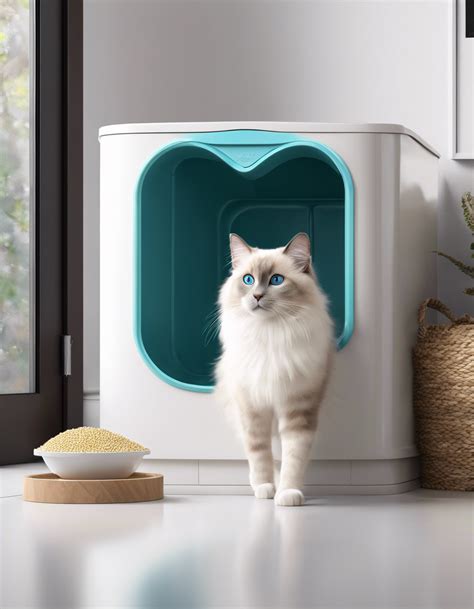Introduction

Litter boxes are an essential part of pet ownership, providing cats with a designated space for their elimination needs. However, traditional litter boxes often fall short in terms of convenience, hygiene, and aesthetics. This has led to a surge in the development of innovative litter box designs that aim to address these shortcomings and enhance the overall pet and owner experience.
Current Status of Litter Box Design
According to the American Pet Products Association (APPA), over 47% of US households own cats, translating to approximately 63 million pet cats. The global litter box market size was valued at USD 1.6 billion in 2021 and is projected to expand at a CAGR of 5.2% from 2022 to 2030. This growth is attributed to the increasing concern for pet hygiene, convenience, and the rising adoption of companion animals.
Innovation in Litter Box Design
The current landscape of litter box design is rapidly evolving, with a focus on improving several key aspects:
-
Convenience: Automated litter boxes that self-clean and dispose of waste, reducing the need for manual scooping and hassle.
-
Hygiene: Antibacterial and antimicrobial materials, along with enclosed designs, minimize odor and reduce the risk of bacterial growth and infection.
-
Aesthetics: Modern litter boxes come in various colors, shapes, and sizes, blending seamlessly into home décor while maintaining functionality.
Key Innovation Examples
-
Self-Cleaning Litter Boxes: These litter boxes feature automatic raking mechanisms that separate and dispose of waste into a sealed container, ensuring a clean and odor-free environment.
-
RFID-Enabled Litter Boxes: These smart litter boxes use radio frequency identification (RFID) technology to track each cat’s usage, providing insights into their bathroom habits and potentially detecting early signs of health problems.
-
App-Controlled Litter Boxes: Mobile applications paired with litter boxes allow pet owners to monitor their cat’s litter box activity remotely, receive notifications for cleaning or refilling, and adjust settings to suit their pet’s needs.
Comparison of Traditional vs. Innovative Litter Boxes
| Feature | Traditional Litter Box | Innovative Litter Box |
|---|---|---|
| Cleaning | Manual scooping | Automatic self-cleaning |
| Odor Control | Limited | Encapsulates and minimizes odors |
| Hygiene | Basic | Antibacterial materials, enclosed designs |
| Convenience | Time-consuming | Hands-free maintenance |
| Aesthetics | Bulky, unsightly | Sleek, modern designs |
| Cost | Relatively low | Higher initial investment |
Pros and Cons of Innovative Litter Boxes
Pros:
- Reduced cleaning time and hassle
- Improved hygiene and odor control
- Convenience and remote monitoring
- Health insights and early detection of potential problems
Cons:
- Higher initial cost compared to traditional litter boxes
- Potential for mechanical issues
- May not be suitable for all cats or households
Strategies for Successful Litter Box Innovation
- Emphasize convenience: Design litter boxes that minimize cleaning time and provide a hassle-free experience for pet owners.
- Prioritize hygiene: Utilize antibacterial materials and enclosed designs to reduce odor and promote a healthy environment for cats.
- Embrace technology: Leverage RFID and app technology to enhance functionality, provide insights, and foster a more connected pet care experience.
- Consider cat preferences: Cater to cats’ natural instincts and preferences by offering various litter box sizes, shapes, and textures.
- Focus on aesthetics: Design litter boxes that blend seamlessly into home décor, improving the overall aesthetic appeal of pet-friendly environments.
FAQs on Litter Box Design and Innovation
-
What are the latest trends in litter box design?
– Automation, hygiene-enhancing materials, and app integration. -
How can I choose the right litter box for my cat?
– Consider your cat’s size, litter preferences, and the desired level of convenience and hygiene. -
Can innovative litter boxes help with litter box avoidance?
– Yes, by providing a cleaner, more inviting environment that addresses common reasons for avoidance, such as odor and unhygienic conditions. -
What are some creative ideas for new litter box applications?
– Litter boxes with built-in health monitoring sensors to detect early signs of disease
– Litter boxes that use sustainable materials and reduce waste -
What are the potential future developments in litter box design?
– AI-powered litter boxes that can provide personalized recommendations
– Litter boxes that integrate with smart home systems for automated cleaning and monitoring -
How can we improve litter box accessibility for cats with disabilities?
– Design litter boxes with low entry points, ramps, and large enough spaces for easy access. -
What are the environmental impacts of traditional litter box usage?
– Traditional litter boxes often contribute to landfill waste due to the disposal of soiled litter and plastic liners. -
What can we do to promote sustainable litter box practices?
– Use flushable or biodegradable litter
– Compost or recycle used litter
– Choose litter boxes made from recycled materials
Conclusion
The future of litter box design is poised for continued innovation, driven by the pursuit of convenience, hygiene, and aesthetics. By embracing new technologies, considering cat preferences, and prioritizing sustainability, we can create litter box solutions that enhance the lives of both cats and their owners.





















